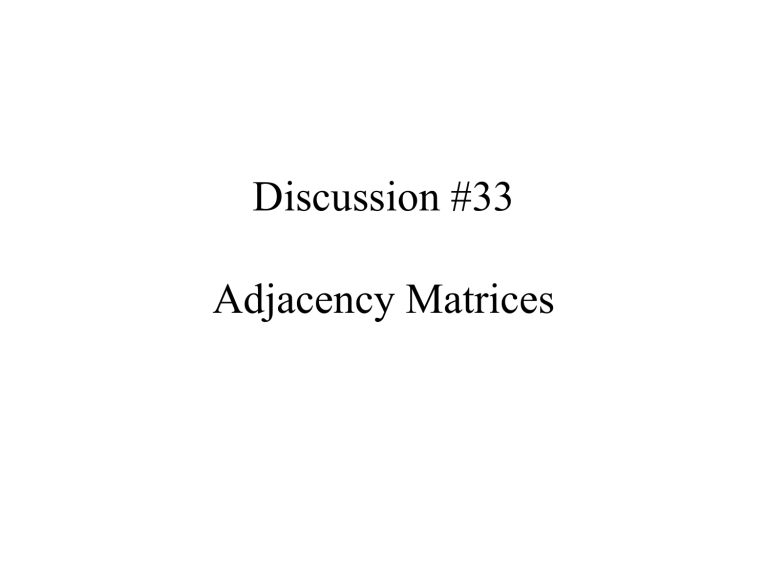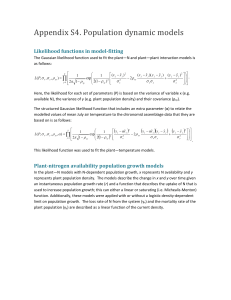Adjacency Matrices - BYU Computer Science Students Homepage
advertisement

Discussion #33
Adjacency Matrices
Topics
• Adjacency matrix for a directed graph
• Reachability
• Algorithmic Complexity and Correctness
– Big Oh
– Proofs of correctness for algorithms
• Loop invariants
• Induction
Adjacency Matrix
• Definition: Let G = (V, E) be a simple digraph. Let V = {v1,
v2,…vn} be the vertices (nodes). Order the vertices from v1
to vn. The n n matrix A whose elements are given by
aij =
1, if (vi, vj) E
0, otherwise
{
is the adjacency matrix of the graph G.
• Example:
3
1
2
A=
4
v1
v2
v3
v4
v1
0
1
0
0
v2
0
0
1
1
v3
0
0
0
1
v4
0
1
0
1
Space: Adjacency Lists vs. Matricies
• Space (n vertices and m edges)
– matrix: n2 + n(vertex-node size)
• = matrix size + header size
• matrix can be bits, but bits are not directly addressable
– list: n(header-node size) + m(list-node size)
• Sparse: few edges 0 in the extreme case
– Matrix fixed size: so no size benefit
– List variable size: as little as n(vertex-node size)
• Dense: many edges n2 in the extreme case
– Matrix fixed size: so no size loss
– List variable size: as much as n(header-node
size) + n2(list-node size)
Operations: Adjacency Lists vs. Matricies
• Operations depend on sparse/dense and what’s being done.
• Examples (n nodes and m edges)
– Is there an arc from x to y?
• Matrix: O(1) check value at (x, y)
• List: O(n) index to x, traverse list to y or end
– Get successor nodes of a node.
• Matrix: O(n) scan a row
• List: O(n) traverse a linked list
– Get predecessor nodes of a node.
• Matrix: O(n) scan a column
• List: O(n+m) traverse all linked lists, which could be as bad as
O(n+n2) = O(n2).
Powers of Adjacency Matrices
• Powers of adjacency matrices: A2, A3, …
• Can compute powers
– Using ordinary arithmetic:
aij =
– Using Boolean arithmetic:
n
k=1
n
aij =
k=1
aikakj
aikakj
Powers Using Ordinary Arithmetic
A=
A2 =
A3 =
3
1
2
3
4
1
0
1
0
0
2
0
0
1
1
3
0
0
0
1
4
0
1
0
1
1
2
3
4
1
0
0
1
1
2
0
1
0
2
3
0
1
0
1
4
0
1
1
2
1
2
3
4
1
0
1
0
2
<1,2,3,4> <1,2,4,4>
2
0
2
1
3
3
0
1
1
2
<2,4,2,4> <2,4,4,4> <2,3,4,4>
<3,4,2,4> <3,4,4,4>
4
0
2
1
4
<4,2,3,4> <4,2,4,4> <4,4,2,4> <4,4,4,4>
1
2
4
<1,2,4>
<2,3,4> <2,4,4>
<3,4,4>
<4,2,4> <4,4,4>
Powers Using Ordinary Arithmetic
(continued…)
3
1
2
4
A4
=
1
2
3
4
1
0
2
1
3
2
0
3
2
6
3
0
2
1
4
4
0
4
2
7
<1,2,3,4,4> <1,2,4,2,4> <1,2,4,4,4>
<2,4,2,4,4> <2,4,4,4,4> <2,3,4,2,4> <2,3,4,4,4>
<2,4,2,3,4> <2,4,4,2,4>
<3,4,4,4,4> <3,4,2,4,4> <3,4,4,2,4> <3,4,2,3,4>
<4,4,4,4,4> <4,4,4,2,4> <4,4,2,4,4> <4,2,4,4,4>
<4,2,4,2,4> <4,2,3,4,4> <4,4,2,3,4>
The element in the ith row and the jth column of An
is equal to the number of paths of length n from the
ith node to the jth node.
Powers Using Ordinary Arithmetic
(continued…)
A=
A2 =
A3 =
1
2
3
4
1
0
1
0
0
A1 + A2 = # of ways in 2 or fewer
2
0
0
1
1
3
0
0
0
1
A1 + A2 + A3 = # of ways in 3 or fewer
4
0
1
0
1
1
2
3
4
1
0
0
1
1
2
0
1
0
2
3
0
1
0
1
4
0
1
1
2
1
2
3
1
0
1
2
0
3
4
A1 + A2 + A3 + A4 = # of ways in 4 or fewer
1
2
3
4
1
0
2
1
3
4
2
0
3
2
6
0
2
3
0
2
1
4
2
1
3
4
0
4
2
7
0
1
1
2
0
2
1
4
0+1+2=
1+2+4=
Powers Using Boolean Arithmetic
• Using Boolean arithmetic, we compute reachability.
• We can compute the paths of length 2 by A2, 3 by A3… and of
length n by An. Since the longest possible path we care about
for reachability is n, we obtain all paths by
A A2 A3 … An.
• The reachability matrix is the transitive closure of A.
• Algorithm:
for (j = 1 to n)
O(n4)
(n-1)nnn
R = A;
for (i = 2 to n)
{ compute Ai;
R = R Ai;
}
{ for (k = 1 to n)
{ aijk = 0;
for (m = 1 to n)
{ aijk = aijk (ai-1jm a1mk);
}
}
}
Reachability
A=
A
A2 =
1
2
3
4
1
0
1
0
0
2
0
0
1
1
3
0
0
0
1
4
0
1
0
1
1
2
3
4
1
0
1
1
1
2
0
1
1
1
3
0
1
0
1
4
0
1
1
1
1st iteration
A
A2
A3 =
3
1
2
4
1
2
3
4
1
0
1
1
1
2
0
1
1
1
3
0
1
1
1
4
0
1
1
1
2nd iteration
A
A2
A3
A4 =
1
2
3
4
1
0
1
1
1
2
0
1
1
1
3
0
1
1
1
4
0
1
1
1
3rd iteration
Timeout … for an Important CS Theme
• Programmatic problem solving
– Understand gather information, analyze, specify
– Solve
• Choose “proper” data structures and algorithms
• Implement
• “Prove” correct
Test Prove
exhaustively?
mathematical proof?
Reason & Test
– Optimize
• Tweak? (Often not much here compilers optimize)
• Can I reduce the Big Oh?
• Example
– Can we prove that the reachability algorithm works?
– Can we find a faster algorithm to compute reachability?
Algorithms: Proof of Correctness
• The algorithm terminates.
– Loops terminate: each has a descending seq. on a well-founded poset.
– Example:
R = A;
for (i = 2 to n)
{ compute Ai;
R = R Ai;
}
The sequence n i for i = 2 to n
is a descending sequence on
the natural numbers. (For our
example it is <2, 1, 0>.)
• The algorithm produces the correct result.
– No loops: Reason that steps lead to the desired conclusion.
– Loops:
• Find an appropriate loop invariant a T/F condition that stays the
same as the loop executes, is based on the number of iterations, and
leads to the conclusion we need.
• Prove by induction that the loop invariant holds as the loop executes.
n
Loop Invariant Example: i=1A[i]
sum = 0
for i = 1 to n
sum = sum + A[i]
Loop invariant: After k iterations, sum = A[1] + A[2] + … + A[k].
Induction proof:
Basis: k = 0 (initialization, before the loop begins), sum = 0, which is the sum
after 0 iterations. (Or, we could start with k=1: After 1 iteration, sum = A[1].)
Induction: By the induction hypothesis, after k iterations, sum = A[1] + A[2] +
… + A[k]. In the next iteration we add A[k+1]. Thus, after k+1 iterations,
sum = A[1] + A[2] + … + A[k+1].
Loop Invariant Example: Selection Sort
-- A is an array of n distinct integers
for i = 1 to n
find location j of the smallest integer in A[i] … A[n]
swap A[i] and A[j]
1 2 3 9 6 5 8
Loop invariant:
After k iterations, A[1], …, A[k] are sorted A[k] < all of A[k+1], …, A[n].
Induction proof:
Basis: k = 0 (initialization, before the loop begins), A is an array of n distinct
integers which may or may not be sorted. (Or, we could start with k=1: After 1
iteration A[1] is sorted A[1] < all of A[1+1], …, A[n].)
Induction: By the induction hypothesis, after k iterations, after k iterations,
A[1], …, A[k] are sorted A[k] < all of A[k+1], …, A[n]. Then since A[k] <
all of A[k+1], …, A[n], and we find the smallest integer in A[k+1], …, A[n] to
swap with A[k+1], A[1], …, A[k+1] are sorted A[k+1] < all of A[(k+1)+1],
…, A[n].
Proof of Correctness for Reachability
R = A;
for (i = 2 to n)
{ compute Ai;
R = R Ai;
}
•
•
•
for (j = 1 to n)
{ for (k = 1 to n)
{ aijk = 0;
for (m = 1 to n)
{ aijk = aijk (ai-1jm a1mk);
}
}
}
Loop invariant: After z outer loops, axy = 1 iff y is reachable from x along a path of
length z+1 or less from x to y.
Note: the loop terminates after n1 outer loops since i runs from 2 to n. Thus, when the
algorithm terminates, if the loop invariant holds, axy = 1 iff y is reachable from x along a
path of length (n1)+1 = n or less from x to y, and thus is reachable since n is the longest
a path can be (that starts at a node N, visits all other nodes once, and comes back to N).
Inductive proof
– Basis: z=0 (i.e. before entering the outer loop), R = A and axy is 1 iff there is a path from x to
y; thus axy = 1 iff y is reachable from x along a path of length 0+1 = 1 or less from x to y.
– Induction: By the induction hypothesis we have that after z outer loops, axy = 1 iff y is
reachable from x along a path of length z+1 or less from x to y. In the z+1 st iteration we
compute A(z+2), in which axy = 1 iff there is a path of length z+1 from x to some node q and an
edge from q to y, i.e. a path of length z+2 from x to y, and we add these reachable possibilities
for paths of length z+2 to the result R, making axy = 1 if it is not already 1 because there exists
a path from x to y that has length less than z+2. Hence, after z+1 outer loops, a xy = 1 iff y is
reachable from x along a path of length (z+1)+1 = z+2 or less from x to y.
Proof of Correctness for Reachability
R = A;
for (i = 2 to n)
{ compute Ai;
R = R Ai;
}
R
Basis: R = A
Induction:
0. A1
1. A1 A2
…
z. A1 A2 … Az+1
z+1. A1 A2 … Az+1 Az+2
…
After z outer loops, axy = 1 iff y is reachable
from x along a path of length z+1 or less from
x to y.
After z+1 outer loops, axy = 1 iff y is reachable
from x along a path of length (z+1)+1 or less
from x to y.
n-1. A1 A2 … An
From the inner loops we know that axy = 1 for a path of length i from x to y iff (x,y) is 1 in Ai.








